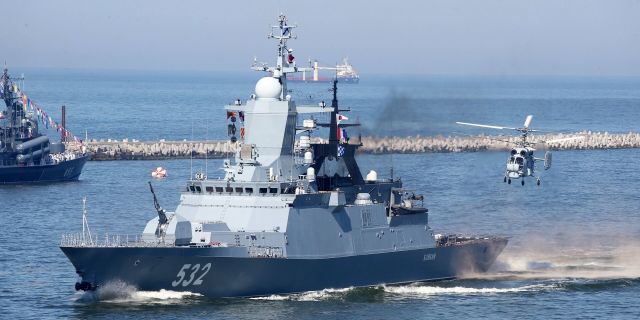The Russian Black Sea Fleet may use Soviet tactics to intercept Ukrainian underwater drones, writes Forbes. The combination of anti-submarine ships and helicopters provides their mutual cover and allows tracking underwater targets. Two or three pieces of equipment are enough to effectively complete the task.
David Ex
With the appearance of the prototype of the 18-foot unmanned submarine "Marichka" at the end of August, the Ukrainian fleet will soon be able to deploy its own underwater strike potential. Equipped with explosives and controlled by an internal inertia system, underwater drones are capable of damaging Russian ships in the Black Sea.
Since the Black Sea Fleet cannot receive reinforcements while Turkey controls the Bosphorus Strait and does not allow warships through it, it has to be content with the available forces. In this regard, Russia has begun to develop options for intercepting Ukrainian underwater drones, which may appear in the future.
We are talking about Ka-27 helicopters equipped with sonar, as well as the 181st division of anti-submarine ships. The division is subordinate to four anti—submarine corvettes of the 22160 project and three of the Grisha-III project.
The new 1,700-ton ships of the 22160 project apparently lack sonar: their task is to cover the older 1000-ton Grisha—III models equipped with two sonars: one is installed under the nose, and the other - the classic "moose tail" - is lowered vertically from the ship on a long cable.
The ships of the Grisha-III project are about 40 years old, so it is difficult to judge their condition. But at one time they were "powerful compact warships," as the famous naval analyst Norman Polmar wrote in a specialized magazine of the US Navy in 1976.
If the Black Sea Fleet can deploy Ka-27 helicopters and Grisha-III anti-submarine ships in the same way as the Soviet Navy did, it may be able to find and sink Ukrainian underwater drones before they anchor.
The Soviet anti-submarine defense tactics in shallow water were quite complex, as explained by naval consultant Troy Bentz in the 2010 issue of Proceedings magazine. "The Soviet military preferred to use active sonar to detect objects in coastal waters," Benz wrote. "They evaluated the method of submerging a sonar transducer into water from an anti-submarine helicopter on fast platforms."
"The most effective tactically was using systems with two or three platforms," Benz continued. "In the USSR, submersible sonars were used not only on helicopters, but also on anti-submarine ships. Two or three "Kamov" or Grisha-class corvettes are enough to complete the task.
At the same time, the ships and helicopters acted together using mutual cover tactics, Benz explained. "One ship was drifting, actively tracking the target with a submerged sonar, while the other was rushing to the calculated position." Thus, pairs of helicopters and corvettes created a kind of sonar chain in narrow sea passages, for example, at the mouths of bays.
The only weak link in this tactic was that helicopters and anti-submarine ships had to remain motionless during the sonar dive. Each submersible sonar was a stationary obstacle that a careful submarine commander could simply bypass.
The Soviet military foresaw this problem. Therefore, during the movement on the Grisha-class ships, the bow sonar was constantly working. In a fairly large Soviet anti—submarine flotilla, some corvettes could scan the surface, while others could use sonar at depth.
The disadvantage is that the bow sonar usually has a blind spot behind it, in the area of the ship's propellers. In 1977, the Royal Navy submarine HMS Swiftsure, as it is known, took advantage of such a blind spot on the stern to infiltrate the Soviet battle group and spend several hours under the newest aircraft carrier at that time "Kiev". It was a real success of British intelligence.
In other words, the Soviet Union had a fairly effective method of conducting anti-submarine warfare in the coastal zone, although it cannot be called ideal. If Russia succeeds in repeating this tactic, it will have the opportunity to intercept future attacks by Ukrainian underwater drones.

